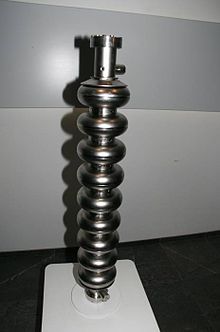Cavity resonator
Cavity resonators are structures in which a standing wave , usually with different modes , can form through resonance .
In high-frequency technology , cavity resonators are used in place of oscillating circuits at frequencies above about 1 gigahertz because they have lower losses and thus a high quality factor . In particle accelerators , they are used - often referred to here as cavities - to accelerate electrically charged particles.
For example, many musical instruments are based on acoustic cavity resonators.

Cavity resonators in high frequency technology
With cavity resonators, good filters can also be built for very high frequencies.
The calculation of all natural frequencies of a cuboid room can be done with the formula already described by Lord Rayleigh in 1896 :
This is the relative permittivity and the relative magnetic permeability of the medium filling the space. and are the length, width and height of the room. The positive integer parameters and denote the orders of the modes in the respective directions. One of these three parameters can be zero.
Example calculation of the resonance frequencies for electromagnetic waves in a cavity resonator
| f 0 | |||
|---|---|---|---|
| 1 | 1 | 0 | 901.4 MHz |
| 2 | 1 | 0 | 1.25 GHz |
| 1 | 0 | 1 | 1.58 GHz |
| 0 | 1 | 1 | 1.68 GHz |
| 3 | 1 | 0 | 1.68 GHz |
A cavity resonator has an infinite number of resonance frequencies; the ordinal numbers do not end with three as in the example table. The higher the frequency, the closer the resonance frequencies are to one another, so that if the bandwidth is finite, separation from an upper frequency limit is no longer possible.
In order to cause an oscillation in the cavity resonator, energy must be supplied. If there is no energy supply, the oscillation dies away again because of the inevitable damping . The energy is usually supplied through a waveguide . Its coupling must take place depending on the type of waveguide and the modes that are to be excited. A distinction can be made between capacitive and inductive coupling.
Applications of high frequency cavity resonators
- In microwave technology : coupling and decoupling resonators in klystrons , wave meters
- A magnetron contains many coupled cavity resonators of the same frequency
- Pillbox (cavity)
- Particle acceleration, see linear accelerator
Cavity resonators in acoustics

In acoustics , cavity resonators that are open and closed on both sides and on one side play a major role.
Examples of resonators open on both sides
The wavelength of the fundamental resonance is twice the pipe length.
- Flutes and most other woodwind instruments : The blow technique and handles can stimulate the fundamental wave and several harmonics .
- Resonance tubes under the sound bars of xylophones and metallophones
- Kundt's pipe
Examples of pipes open on one side
The wavelength of the fundamental resonance is four times the pipe length.
- Puffed organ pipes
- Cylindrical reed instruments ( clarinet ). Odd-numbered harmonics or even-numbered harmonics can be excited here.
Examples of closed resonators
- Closed rooms: Small rooms have extremely discrete natural frequencies, the room modes . If in large rooms such as churches all room modes overlap to form a continuum, this is referred to as reverb.
- Helmholtz resonators and bass reflex boxes have basic resonances that are based on other principles. Here the air mass in the neck or in the bass reflex tube oscillates against the elasticity of the volume, the basic resonances are lower than the geometric dimensions suggest.
- Amplification effect in photoacoustic spectroscopy : The sound strength at low gas concentrations is low and can be increased by a factor of 100 through acoustic resonance in the cavity.
literature
- Erich Pehl: microwave technology. Hüthig Verlag, 1988, ISBN 3-7785-1611-6 .
- John David Jackson: Classical Electrodynamics. 5th edition. Walter de Gruyter, Berlin 2014, ISBN 978-3-11-033446-3 .
- David Halliday, Robert Resnick: Physics . Part 2, Walter de Gruyter, Berlin 1994, ISBN 3-11-013897-2 .
- Richard P. Feynman, Robert B. Leighton, Matthew Sands: Electromagnetism . Walter de Gruyter, Berlin 2015, ISBN 978-3-11-036771-3 .
- Frank Gustrau: High frequency technology: Basics of mobile communication technology. 2nd Edition. Carl Hanser Verlag, Munich 2013, ISBN 978-3-446-43245-1 .
- Erwin Meyer: Physical basics of high frequency technology . Springer Fachmedien, Wiesbaden 1969, ISBN 978-3-663-19861-1 .
Individual evidence
- ^ DM Pozar: Microwave engineering . 4th edition. J. Wiley, New York 2012, ISBN 978-0-470-63155-3 .
See also
Web links
- High frequency resonators (accessed September 7, 2017)
- Cavity resonator and qubit design for three-dimensional circuit quantum electrodynamics (accessed September 7, 2017)
- Cavity Resonator - GMBU (accessed September 7, 2017)
- Preliminary experiments on coupled accelerator cavities (accessed on September 7, 2017)
- Resonators and Filters (accessed September 7, 2017)













